Sotanghon Guisado : Cellophane Noodles Sauteed with Snow Peas
As an Amazon Associate and member of other affiliate programs, I earn from qualifying purchases.
This Sotanghon Guisado – Cellophane Noodles with Snow Peas noodle dish was cooked one weeknight when I absolutely had no time to cook. But we still needed to eat. It was one of those days. I was running late. I was swamped with work. When I looked at the clock, I panicked. It was almost 5 o’clock. This only meant supper was an hour away. I had nothing. The kitchen fires were cold. The kitchen was dark and the light was still turned off.
Quickly I scanned the contents of my refrigerator’s vegetable bin. I had a big bag of snow peas, just in from the Asian market. I had some leftover pork pieces from the barbecue skewers the other day. From my pantry, I had my staple ‘sotanghon noodles’ (say ‘soh-tang-hon’). These are light noodles, if uncooked look thin and translucent. When soaked then mixed into the stir fry dish, they become as transparent as glass. They are also called ‘cellophane noodles’ and made from mung bean starch, according to author, Pat Tanumihardja in“The Asian Grandmothers Cookbook.”
I have always loved these type of shiny noodles in Filipino recipes. Years ago, my mom made sotanghon-based noodle dishes often for parties or big events. Back then, I thought it was because sotanghon was expensive. On the contrary. These cellophane noodles are very affordable and can be found in Asian markets. Once cooked, they expand and the amount increases, thus extending serving sizes even more. The more noodles, the better for everyone around the table.
What are snow peas? Snow peas are also called ‘sitsaro’ (say ‘seet-sah-roh’) in the Philippines and usually available all year long. I find them all the time. These are flat, about 2 inches long, and have pointed tips which contain those fibrous string-like stems. You want to pull on those strings at the end with your fingers. It’s a cinch to do. You can even do this routine of taking out the fibrous thread while the ‘sotanghon noodles’ are soaking in water, which only needs a 20 minute soak.
Prep time to get all your ingredients in order is only a few fast minutes. The best part of cooking for me is to hear the sizzle of the saute and inhale the Asian aromas of fish sauce from this activity. Like I’ve always said if you can saute garlic and onions, then it’s easy going from there on. Throw in the chopped celery, the pork bits and pour the rest of the ingredients. If you can manage to toss in some of that achuete oil, the noodles will turn a bright, blazing orange color. The flavors in the saute skillet suddenly come alive. Achuete oil (from annatto seeds cooked in oil and garlic) emits a nutty, roasty flavor which coats itself all round the clear noodles.
As you twirl the fork or chopsticks around the slippery, slinky noodles, catch a few pieces of the crisp snow peas along the way. Gather it all in a bundle, grasp it, chomp on it and just wallow in how deliciously easy it was to save supper tonight.
Sotanghon Guisado- Cellophane Noodles Sauteed with Snow Peas
Ingredients
- 16 ounces cellophane noodles pre-soaked in water, 2 cups uncooked (from Asian markets)
- 1/4 pound boiled pork belly cut in 1 inch cube pieces
- 2 Tablespoons vegetable
- 4 Tablespoons achuete oil annatto seeds cooked in garlic and vegetable oil
- 1 whole onion chopped
- 4 cloves garlic minced
- 1 stalk celery chopped (about 3/4 cup)
- 2 Tablespoons patis (fish sauce)
- 1 cup vegetable or chicken broth
- 2 cups snow peas edges trimmed; 'sitsaro' in Pilipino
- 1 whole fresh lemon to get about 1 Tablespoon lemon juice
- 1-2 stalks scallions chopped, for garnish
Instructions
- In a medium sized bowl filled with water at room temperature, soak the noodles for 20 minutes. Then drain noodles in a colander. Set aside till ready to use.
- In a large skillet, over medium high heat, add both the vegetable and achuete oil. Once oil is hot after 1 minute, add the onions, garlic and celery. Add the pre-boiled pork belly cubes. Saute for 2 to 3 minutes till vegetables are soft.
- Add the patis or fish sauce. Then add the broth. Let the liquid come to a boil in about 2 minutes, then lower heat to a simmer.
- Add the snow peas and cook for 1 to 2 minutes. Do not overcook the snow peas or they will not be crisp. Mix in the drained cellophane noodles to the simmering saute. Toss all the ingredients together. The noodles will cook and soften in 1 to 2 minutes within adding to the skillet. Sprinkle with the juice of a lemon all over. Garnish with green onions. Serve hot.
- ACHUETE OIL RECIPE : I often use achuete oil in many dishes. It is something I make ahead and store in the refrigerator.Find the complete Achuete oil recipe is in a previous post. Annato or achuete provides the appetizing orange glossy colors of the dish, as well as a nutty, salty flavor. If preferred, you may omit the use of the annato oil and add more vegetable oil to the saute.
- Cook's Comments: Thanks to a reader's comment, I corrected the error and added the pork belly cubes in the instructions during the sauté. For this recipe, I pre-boiled the pork belly ahead in water for 20 minutes (for this amount) to pre-cook and soften the meat.
Hello, Friends! All the images and content here are COPYRIGHT PROTECTED. This means BY LAW you are NOT allowed to use my photos or content on your site without my permission. If you want to republish this recipe, please re-write it in your own words and simply link back to this blog to give proper attribution. It’s the LEGAL thing to do. Thanks for your cooperation.Email me at [email protected]
Nutrition
Notes on Nutrition: The nutrition information provided is an estimate and will vary based on cooking methods and specific brands of ingredients used.
Did you like this recipe?I have more Filipino Instant Pot recipes in my newest cookbook Instant Filipino Recipes: My Mother’s Traditional Philippine Cooking in A Multicooker Pot by Elizabeth Ann Besa-Quirino. I also have more classic recipes inspired by my mother’s cooking in my popular cookbook: My Mother’s Philippine Recipes. If you’re learning how to cook Filipino food or a fan of Philippine cuisine, buy my cookbooks and books on Amazon.com sold worldwide in paperback and Kindle format.
Copyright Notice: Hello, Friends! Please DO NOT LIFT OR PLAGIARIZE my original recipe, stories, photos or videos. All the images and content on this blog are COPYRIGHT PROTECTED and owned by my media company Besa-Quirino LLC. This means BY LAW you are NOT allowed to copy, scrape, lift, frame, plagiarize or use my photos, essays, stories and recipe content on your websites, books, films, television shows, videos, without my permission. If you wish to republish this recipe or content on media outlets mentioned above, please ASK MY PERMISSION, or re-write it in your own words and link back to my blog AsianInAmericaMag.com to give proper attribution. It is the legal thing to do. Thank you. Email me at [email protected]

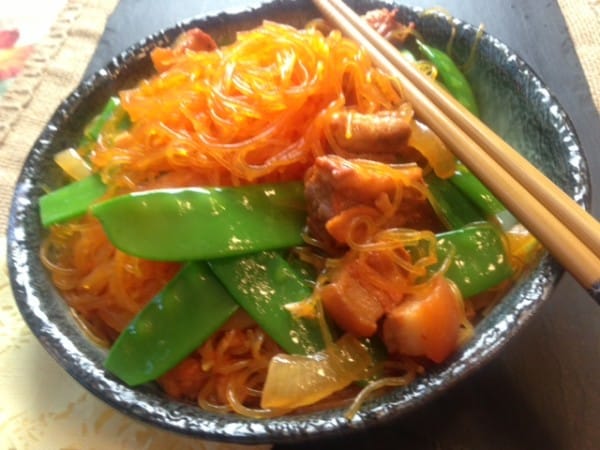
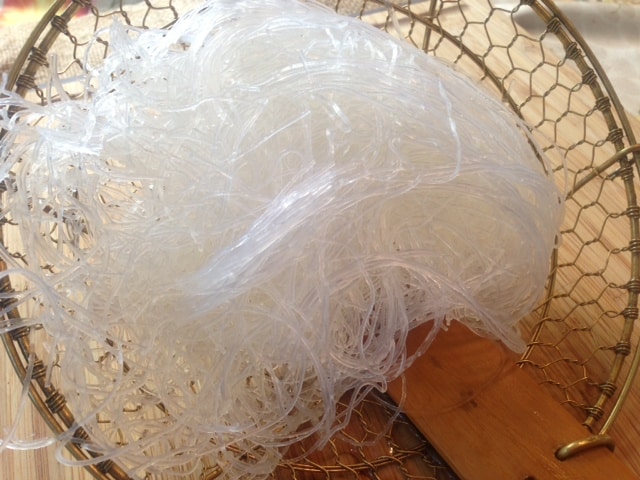
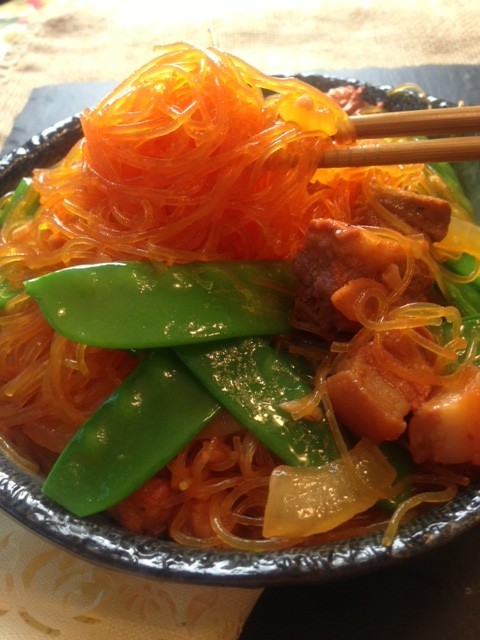

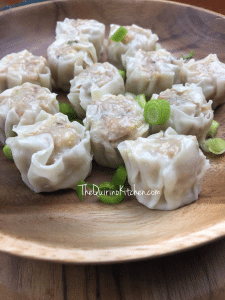
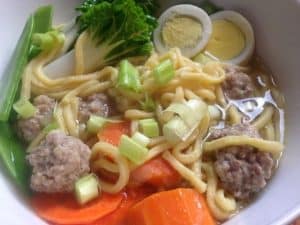

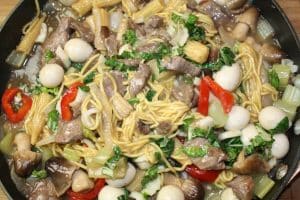
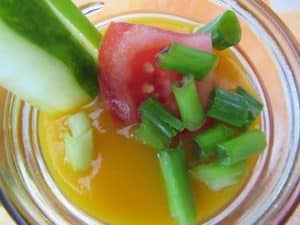
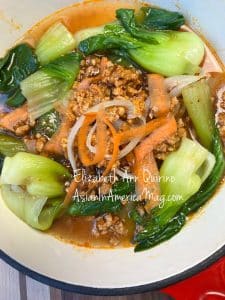
I love cellophane noodles and they are extra good when noodles suck up all the juice from the meat and veggies… this sounds like a nice comforting food!
Thanks, Nami. I love cellophane noodles and have bundles of them in my pantry. If I’m not using rice, I’m cooking with cellophane noodles. I also love it in sukiyaki. Glad you came by, always a treat 🙂
Oh, Betty Ann, this looks so wonderful! I love that you just did a quick inventory of your kitchen and then threw this together. When you know how to cook, you know how to cook!
I have never worked with those noodles before. I have no idea why not–they are gorgeous. Love how they shine in the light, and I bet the soak up all the flavors from the sauce! Will have to grab some on my next trip to Grand Asia Market!
Hi Jenni! These cellophane noodles (sotanghon noodles) are always in my pantry because they are one of the easiest types to prepare. If desired, you can even add them to boiled chicken and broth and have a fantastic chicken noodle soup, Asian version. Thanks for stopping by ~ what a treat to have you visit the blog 🙂
sotanghon is my go to noodles… it never fails to bring in that special touch to dinner.
Thanks for the blog love as always mi amiga. Im trying to squeeze some blogging while i here.
Thanks, Malou. We share the same love for all of the same dishes, condiments, ingredients. It’s always a pleasure showcasing your recipes and your creative flair with Filipino dishes ~ so it’s a treat to have you come visit the blog, too!
I LOVE cellophane noodles. I first discovered them in Thai spring rolls, but I use them in other dishes now too. This one looks fantastic and easy! Pinning now!
Thanks, Laura. We love it, too. I always have cellophane noodles in my pantry. For busy nights, stir fry and throw together vegetables on them for a easy, delish meal or soup dish for chilly nights 🙂
The pork belly is not not added in the instruction.
Thanks, Tish. I made the correction in the instructions. Thank you for spotting the error.
Wanted more asian recipes.loved all posts.
Thanks, Joel. Glad you liked this recipe and the blog 🙂
Can i prepare it the night before and just warm it up the next day for our Christmas party?
Hi, Del. I have not pre-cooked this dish the day before yet. But I think if you do so then I suggest you refrigerate this sotanghon guisado dish, re-heat and serve it the very next day.
Hello…can i use annatto powder?
Hi Jeane. Yes, you can use annatto powder. I suggest you melt in first in warm water before mixing it into the saute.